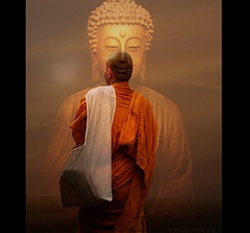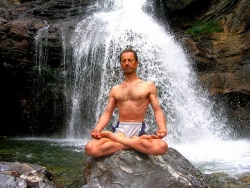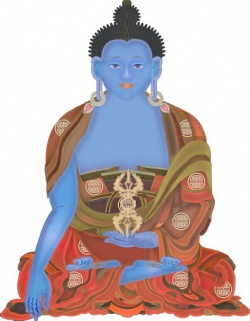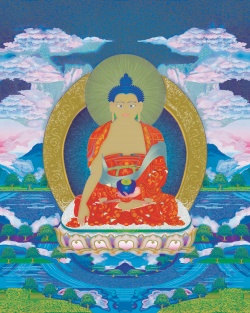The Mystical, Ritual Objects of Esoteric Buddhism
If you ever visit the Kyoto National Museum, look for works like these in Room 16 (Metalwork), on the 2nd Floor of the New Exhibition Hall.
The city of Kyoto has many old temples. Among these, some of the oldest are temples of the Shingon and Tendai sects of Esoteric Buddhism. Have you ever been to a Esoteric Buddhist temple? If you have, then you know that in the center of such temples is an altar with some strange-looking objects on it. These mystical objects are used for Esoteric Buddhist spiritual training.
What, you may be wondering, is Esoteric Buddhism? Well, Esoteric Buddhist practitioners chant magical incantations, try to envision (imagine) the Buddha, form symbolic positions with their hands called "mudras" and do various other types of mystical training. They do all this to release themselves from worries and suffering. At the same time they pray for other people too.
Esoteric Buddhism began in ancient India, was brought to China, and finally to Japan. In the Nara Period (7th-8th Centuries), statues of Kannon Bosatsu (the Bodhisattva Avalokitesvara, one of the images used in Esoteric Buddhism) were worshipped in temples all over Japan. Also many practitioners went deep into the mountains to do spiritual training, as Esoteric Buddhist priests do. But Esoteric Buddhism as an organized religion did not begin till the Heian Period with two famous Esoteric priests named Kukai and Saicho. These men left Japan in the early Heian Period to go to Tang Dynasty China. When they came back to Japan, they brought with them the religious system of Esoteric Buddhism.
Now, how do you think they were able to "bring" the new religion of Esoteric Buddhism to Japan? Well, first they had to bring all the religious scriptures (the written documents). In the case of Esoteric Buddhism, these scriptures are called sutras. Then they had to bring lots of paintings and charts related to the religion. Finally, they had to bring all the ritual objects, or implements, needed for religious ceremonies.
The ritual objects we will talk about today were modeled after those brought back from China by Kukai and Saicho. These are metalwork objects that were made in Japan between the Heian Period and the Kamakura Periods (9th-14th Centuries) and have been used through the ages in various Esoteric Buddhist temples throughout Japan.
One kind of ritual object is the Kongo vajra (meaning thunderbolt), which often has sharp, dagger-like prongs. Kongo vajra can have one, three, five, or more prongs on each end. Some have Buddhist jewel designs. Now why do you think that these vajra look like daggers? The truth is that in ancient India, they were originally made to be weapons to protect the practitioners of Buddhism! While undergoing their Buddhist training, the practitioners would hold these very important tools in their hands in order to protect themselves from evil!
The early vajra brought from Tang China and those made in the Heian Period had very sharp central prongs with vigorously curved side prongs, so they really looked like weapons! By the end of the Kamakura Period, however, the prongs had become dull and the curve of the side prongs was less distinct Now why do you think that these vajra look like daggers? The truth is that in ancient India, they were originally made to be weapons to protect the practitioners of Buddhism! While undergoing their Buddhist training, the practitioners would hold these very important tools in their hands in order to protect themselves from evil!
The early vajra brought from Tang China and those made in the Heian Period had very sharp central prongs with vigorously curved side prongs, so they really looked like weapons! By the end of the Kamakura Period, however, the prongs had become dull and the curve of the side prongs was less distinct.
Look at the differences in the two vajra above. One was made in the Heian Period in the other was made in the late Kamakura Period, about 250 years later! Why do you think these shapes changed over time? One possible answer is that because vajra were used over the ages only for ritual ceremonies, their original purpose as weapons were forgotten and only the form remained!
Next let's look at another type of ritual object, the Kongo bell. These bells also have prongs or a Buddhist jewel on the handle end, but at the other end they have a metal bell. While the practitioners were doing their religious training, they would actually ring these bells! Esoteric Buddhism has many Buddhas and gods. At the beginning of their ritual, the practitioners used these bells to call the relevant Buddhas and gods. When they were finished, they used the bells to send the Buddhas and gods back. The bell used most frequently for these ceremonies was the five-pronged bell.
One bell and one vajra formed a set that would be placed on the a special "Kongo tray" on the altar in front of the practitioner.
There are five kinds of handles on Kongo bells: one prong, three prong, five prong, Buddhist jewel and Buddhist stupa. Each kind of bell symbolizes one of the five main Buddhas of Esoteric Buddhism, called the Five Buddhas of Wisdom. In order to perform a ritual, the practitioner would place the Buddhist stupa bell in the center, representing the Buddha Dainichi Nyorai, and place the other bells at the north, south, east and west corners of the altar. In this way, the practitioners could carry out their rituals literally right in front of the Buddhas!
There are various other types of ritual objects used in Esoteric Buddhism, each with its own particular meaning. Esoteric Buddhism was brought to Japan about 1200 years ago, but it is still practiced today. If you ever visit an Esoteric Buddhist temple, be sure to look for these metal, ritual objects. If you pay careful attention to where and how they are used, I am sure you will make some new discoveries!
Text by Tomoyasu Kubo, Department of Archives
Illustrations by Satoshi Ichida, Department of Public Relations
English Translation by Melissa M. Rinne, Department of Archive



